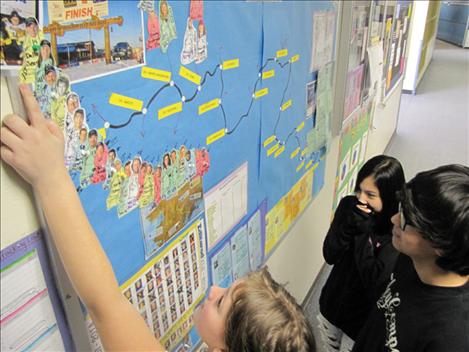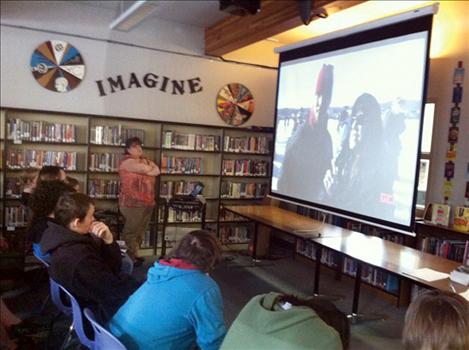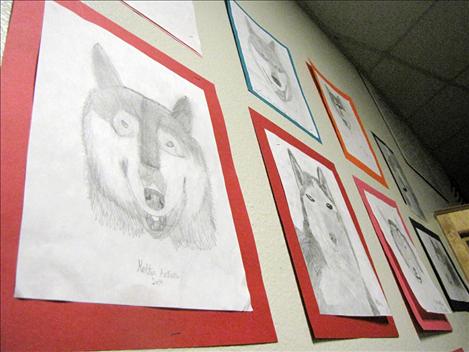‘Woodsong’ reading project connects readers with Iditarod
Hey savvy news reader! Thanks for choosing local.
You are now reading
1 of 3 free articles.
News from Polson Middle School
POLSON — Polson Middle School’s reading time has gone to the dogs, literally.
As part of the One Book, One Community program, students in grades five through eight are reading popular author Gary Paulsen’s Woodsong, a memoir about his experiences raising and running sled dogs in northern Minnesota, and eventually participating in the grueling and unforgiving Iditarod race. Paulsen’s motto, “Read like a wolf eats,” became the driving force for this entire project.
Language Arts and Reading teachers Melissa Bahr and Lori McCurdy received a grant from Catching the Dream in Albuquerque, N.M. This grant, designed to promote and improve reading, allowed Polson Middle School to purchase 200 copies of Woodsong for teachers and students to share. The grant also helped purchase prizes to award and motivate students to read, read, read.
Students connected Paulsen’s book to two of this year’s sled dog races, Race to the Sky, which took place near Helena in February, and the Iditarod, which officially began March 2, in Anchorage, Alaska. It was fortunate for Polson Middle Schoolers that both races took place during the time that the book was being read throughout the school. This allowed for real-time, real-place, real-world connections to be made, enriching the connection between the book and the events.
Throughout grades 5-8, classes “adopted” mushers and charted their progress as they made their way through the 975-mile journey from Anchorage to Nome, Alaska. Since this was an even year, mushers and their dog-teams traveled the northern route of the trail, which includes 25 checkpoints spaced throughout the arctic of Alaska. An Iditarod “race-center” was set up on the bulletin board across from the main office near the entrance to the lunchroom, where everyone entering the school could see it. Based on the information posted from the most recent check-ins provided on the website, www.iditarod.com, classes disseminated the information from the current race standings, charting their musher’s progress and moving their racer’s “bobble-head” to the current checkpoint.
“I greatly enjoyed seeing the students, staff, and parents making a point to check the race board throughout the day. Much like sitting around the campfire telling stories, the Iditarod ‘race center’ gave people an opportunity to explore their curiosities, discuss the latest stats, collectively wonder how ‘their’ musher was doing, or tell stories of their own experiences with dogs, mushing, Montana or Alaska, truly bringing to life the intentions of One Book, One Community,” said Middle School Teacher Amy Williams.
Classes competed, just like the mushers, for the first place spot, and the red lantern award; Mrs. Fansher’s 5th-grade class had Dallas Seavey, this year’s record setting first place finisher, and Mr. Kolattukudy’s 5th period 7th-grade class took the Red Lantern award with their musher, Marcelle Fressineau.
Many teachers and students can only be described as Iditarod-fanatics, checking often throughout the school day and over the weekend, just to see where “their” musher was in the race, and to see when, where, and why some of the competition was forced to “scratch” from the race. Fear not, as of Wednesday, March 19, there were roughly 347 days until next year’s race start.
To satisfy the need for immediate information, the school library offered up-to-the-minute updates via GPS tracking, pre-recorded video stories, and live broadcasts at the finishing line. Lou Anne Krantz, middle school librarian, was amazed at the numbers of students and staff who would pop in to check out the current race standings before and after school, or during their recess time. “Students were curious, and this was such a great way to use technology to instantaneously link the book and the actual race,” said Krantz.
Williams agreed.
“We don’t always get these great opportunities to connect what we are learning in the classroom with what goes on in the world around us,” said Williams.
Many teachers shared that they appreciated the presentations offered in the library to not only introduce the book Woodsong, but give the true history of the 1925 diptheria epidemic in Nome, Alaska, which was just one of the contributing factors to the creation of the Iditarod race. Students were enthralled with the videos and information shared.
Students also participated by doing an “Idita-read,” racing their reading time, with an overall goal of 975 minutes, against the miles raced by the mushers. Four “Read-ins” were offered before and after school in the library, and 80 students, grades 5-8, stopped by for hot chocolate and time with a good book.
Throughout March, students are reading together and independently to achieve their reading goals, logging their minutes and moving their own “dog” throughout the checkpoints set up throughout the hallways. To mimic the prizes mushers could earn for being first to certain checkpoints along the trail, students earn treats at certain checkpoints, including Scooby snacks, ice cream bars, smoothies, and a Silverwood ticket. All reading logs will be collected March 21, and a grand total of minutes read, school-wide, will be posted.
Many teachers truly banded together school-wide as a community, teaching lessons address the wide array of topics surrounding the Iditarod, mushing, Montana, Alaska, and dogs.
Mr. Todd’s art students created beautiful sketches of many different sled-dogs, and have displayed them throughout the school for our viewing pleasure. Mrs. Mills’ 5th-grade students researched the ramifications of keeping wolves as pets, and the connections between Alaska Natives and dog-sledding. Mrs. Morrison’s 6th grade students learned about weather and climate changes that affect areas along the race trails in Montana and Alaska. Mrs. LaPierre’s math students calculated the finances needed to support an endeavor such as the Iditarod, as well as the supplies that would be needed to travel with a team of up to 16 dogs from checkpoint to checkpoint. Mrs. Dalbey’s 7th grade life-science students made connections, using the book, and the movie “White Fang,” to ecosystems, food-webs, and the impacts of having wild animals, such as wolves, as pets. Mr. Kolattukudy’s, Mrs. Bahr’s and Mrs. McCurdy’s 7th and 8th grade language arts classes joined to experience many of the trials and tribulations of the trail as they read the book together. Ms. Williams’ multi-leveled 1st, 3rd and 4th period classes were responsible for posting race standings, double checking that the race center was up to date, and classes had moved their mushers to the appropriate race checkpoints.
The middle school’s Pirate News Network gave daily updates as things progressed in the race, and taught various daily facts surrounding the race, such as the meaning of the word “Iditarod” and why it was chosen as the name of this amazing race. Students and staff also posted pictures and stories of their own favorite dogs to the “dedicated to dogs” bulletin board.
Through this project, students and staff learned a great deal about the Iditarod, perseverance, determination, and the bonds that can be formed between humans and animals. The Iditarod race and the connections made by this One Book, One Community experience has left a lasting impression on many of our students and staff. Woodsong author Gary Paulsen said it best : “The adventure really begins in differences — the great differences between people and animals, between the way we live now and the way we once lived.”



















